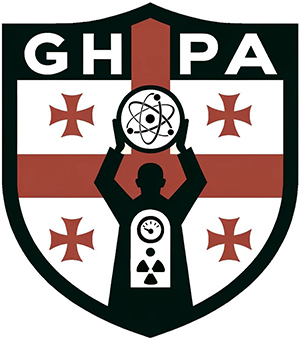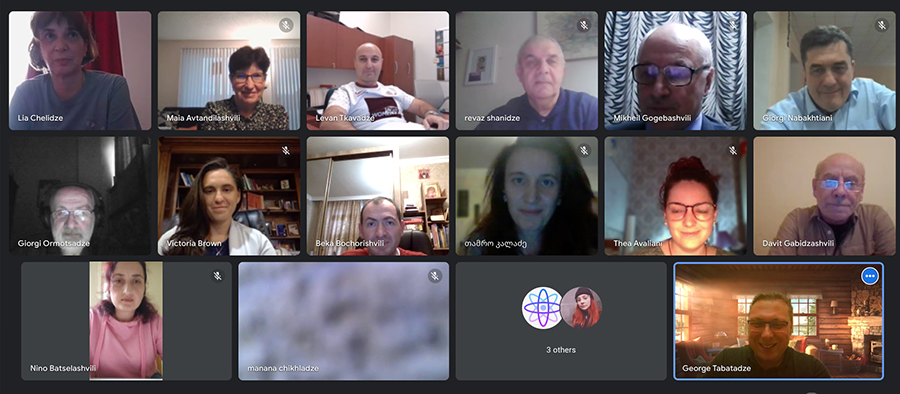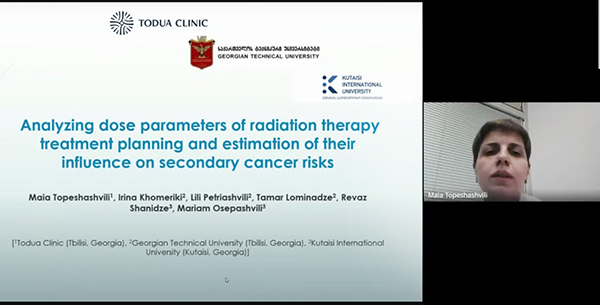News Archive
 George Tabatadze, Chapter Web Editor/Webmaster
George Tabatadze, Chapter Web Editor/Webmaster
Photos courtesy of George Tabatadze
In a series of technical meetings held by the Georgian Health Physics Association (GHPA) during the fall of 2023, a trio of experts presented on the latest advancements in radiation therapy techniques and applications.
 The first fall meeting of GHPA took place on 29 September 2023. At the commencement of this gathering, GHPA members were addressed by Victoria Brown, chair of the Health Physics Society's Society Support Committee. Her introductory remarks were followed by a technical presentation delivered by Beka Bochorishvili, a renowned medical physicist from Todua Clinic (Tbilisi, Georgia). Bochorishvili's talk, "Basic Aspects of Proton Beam Therapy," explored the ever-evolving field of cancer diagnosis and treatment. He discussed the physical, technical, and biological aspects of proton-beam radiotherapy. He outlined the main advantages of proton therapy over photon therapy: the better possibility of dose escalation, which increases the probability of curing cancer; reduction of the dose to healthy tissues, which improves patients' life quality; reduction of the low-dose region, which decreases the probability of secondary malignancies.
The first fall meeting of GHPA took place on 29 September 2023. At the commencement of this gathering, GHPA members were addressed by Victoria Brown, chair of the Health Physics Society's Society Support Committee. Her introductory remarks were followed by a technical presentation delivered by Beka Bochorishvili, a renowned medical physicist from Todua Clinic (Tbilisi, Georgia). Bochorishvili's talk, "Basic Aspects of Proton Beam Therapy," explored the ever-evolving field of cancer diagnosis and treatment. He discussed the physical, technical, and biological aspects of proton-beam radiotherapy. He outlined the main advantages of proton therapy over photon therapy: the better possibility of dose escalation, which increases the probability of curing cancer; reduction of the dose to healthy tissues, which improves patients' life quality; reduction of the low-dose region, which decreases the probability of secondary malignancies.
 The 6 October meeting featured Maia Topeshashvili, MS, chief medical physicist from the Radiation Oncology Department at Todua Clinic. The meeting focused on the vital topic of estimating secondary cancer risk following breast cancer radiotherapy, employing organ equivalent dose (OED) concepts. Topeshashvili's presentation provided crucial insights into this subject, detailing findings from a study involving multiple breast cancer patients.
The 6 October meeting featured Maia Topeshashvili, MS, chief medical physicist from the Radiation Oncology Department at Todua Clinic. The meeting focused on the vital topic of estimating secondary cancer risk following breast cancer radiotherapy, employing organ equivalent dose (OED) concepts. Topeshashvili's presentation provided crucial insights into this subject, detailing findings from a study involving multiple breast cancer patients.
 The fall meetings concluded with a November 3 presentation by Dr. Darrell Fisher from Versant Medical Physics and Radiation Safety, who leveraged his extensive experience to discuss high-dose precision radionuclide therapy (PRnT). Fisher's presentation was centered around overcoming the challenges in radiation therapy, primarily the adverse effects on nontarget organs and tissues due to unwanted radiation doses. He introduced an ideal radionuclide therapy model that enables nearly 100% treatment dose delivery within the clinical target volume, by localizing the dose and minimizing radionuclide out-migration from tumors. The breakthrough approach of direct intra-tumoral injection of yttrium-90 microparticles delivered in a sterile polymer composite matrix, as shared by Fisher, paves the way for potential oncology applications in both human and veterinary patients, especially for tumors that are poor candidates for surgical excision or external beam therapy.
The fall meetings concluded with a November 3 presentation by Dr. Darrell Fisher from Versant Medical Physics and Radiation Safety, who leveraged his extensive experience to discuss high-dose precision radionuclide therapy (PRnT). Fisher's presentation was centered around overcoming the challenges in radiation therapy, primarily the adverse effects on nontarget organs and tissues due to unwanted radiation doses. He introduced an ideal radionuclide therapy model that enables nearly 100% treatment dose delivery within the clinical target volume, by localizing the dose and minimizing radionuclide out-migration from tumors. The breakthrough approach of direct intra-tumoral injection of yttrium-90 microparticles delivered in a sterile polymer composite matrix, as shared by Fisher, paves the way for potential oncology applications in both human and veterinary patients, especially for tumors that are poor candidates for surgical excision or external beam therapy.
Information on these and other past and future GHPA meetings can be found on the GHPA website.



